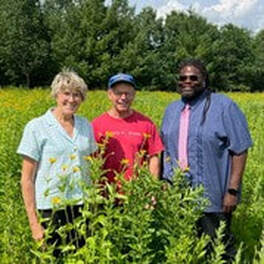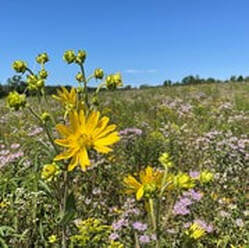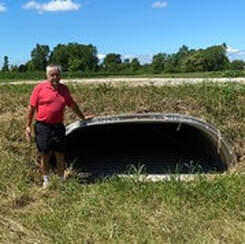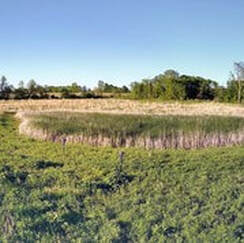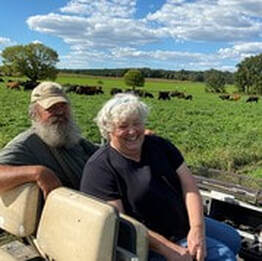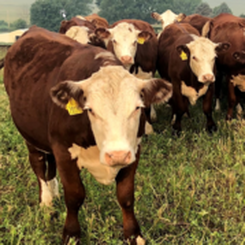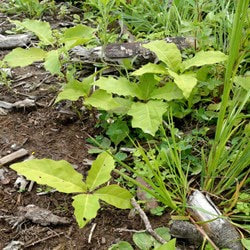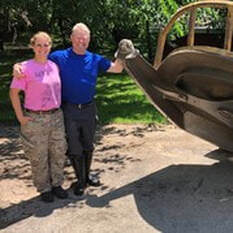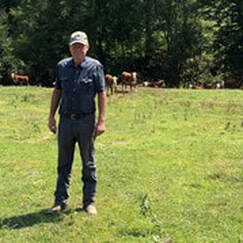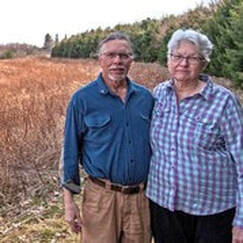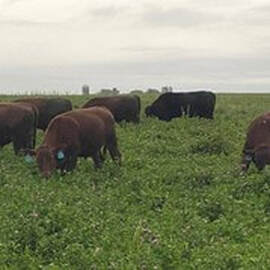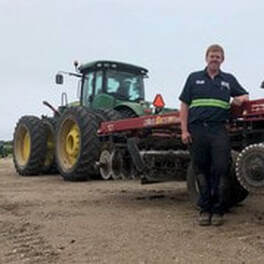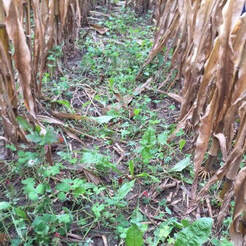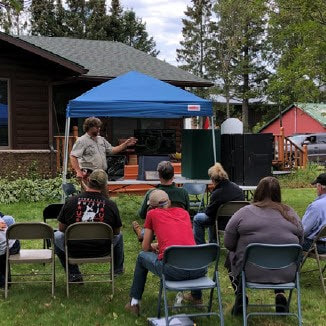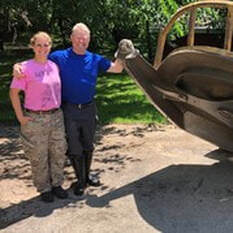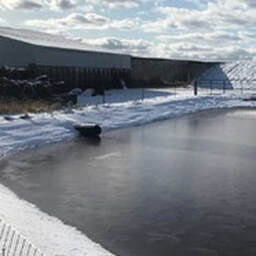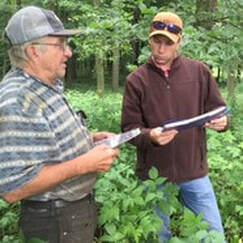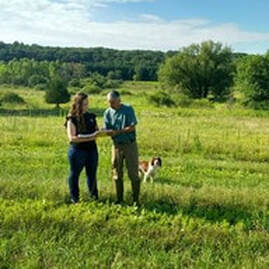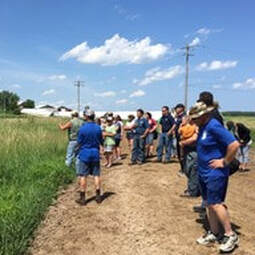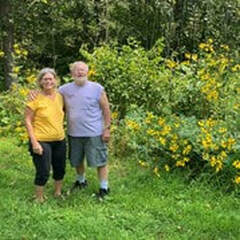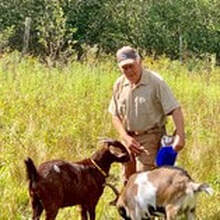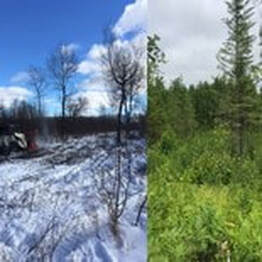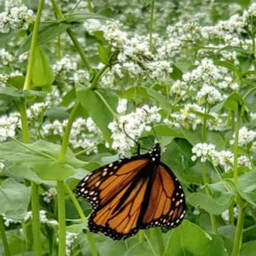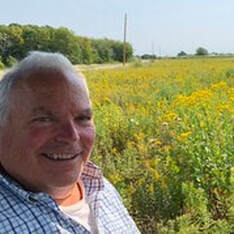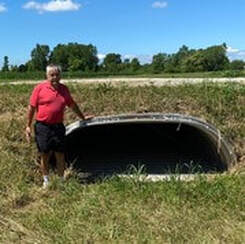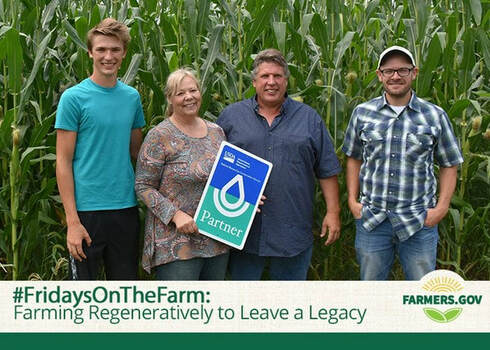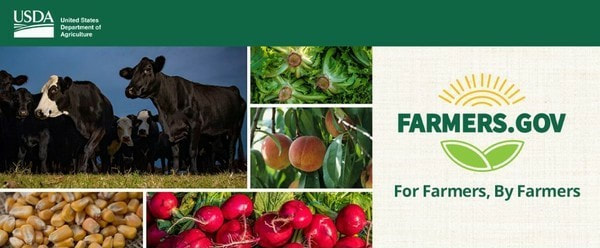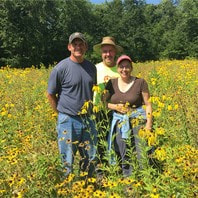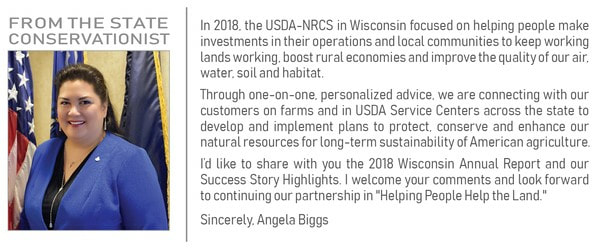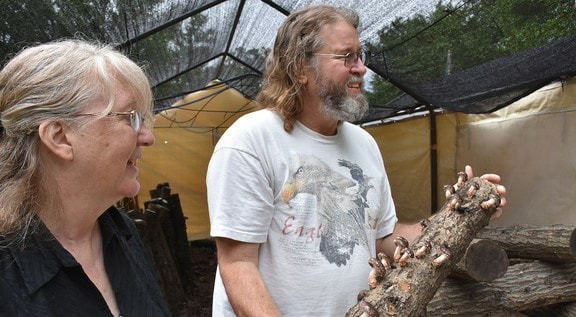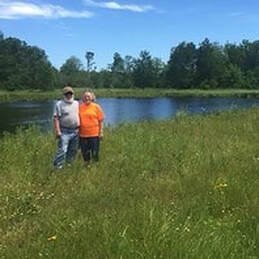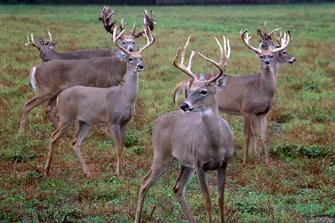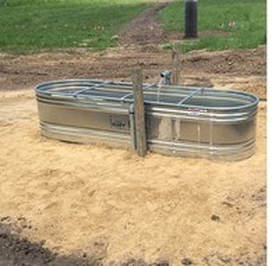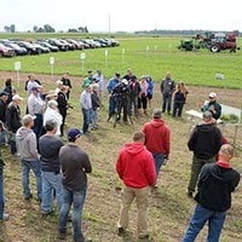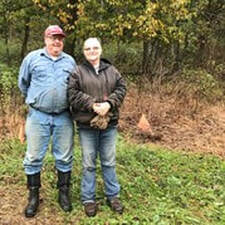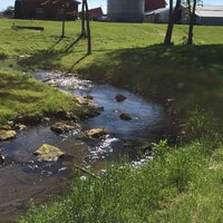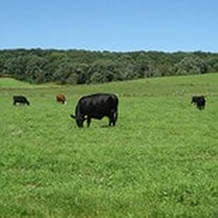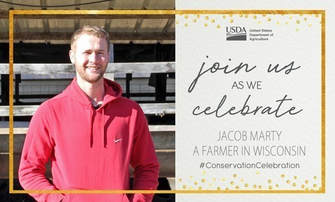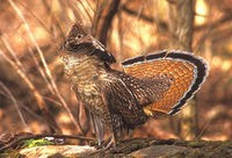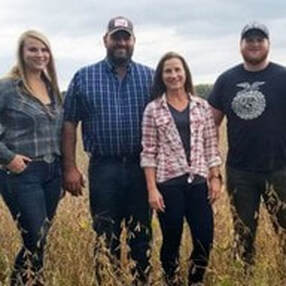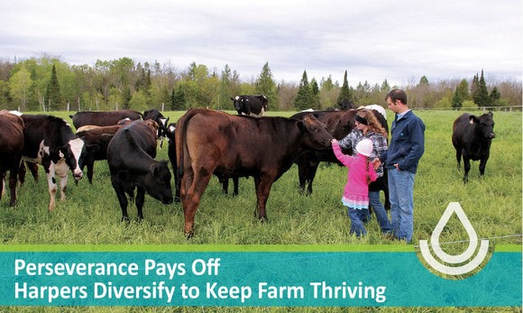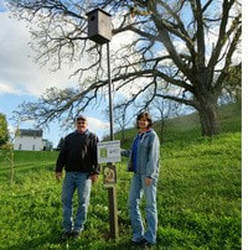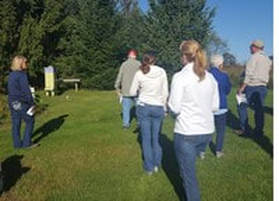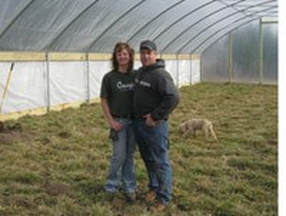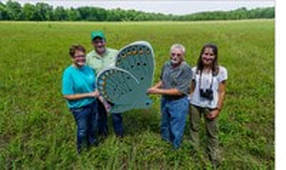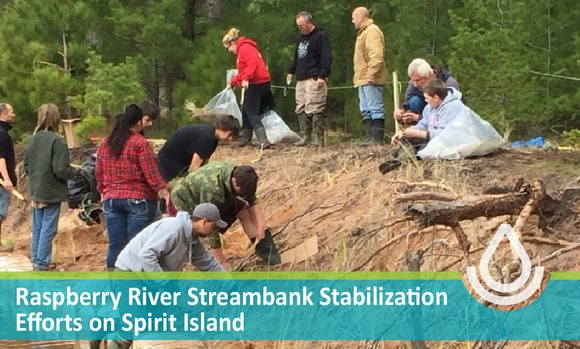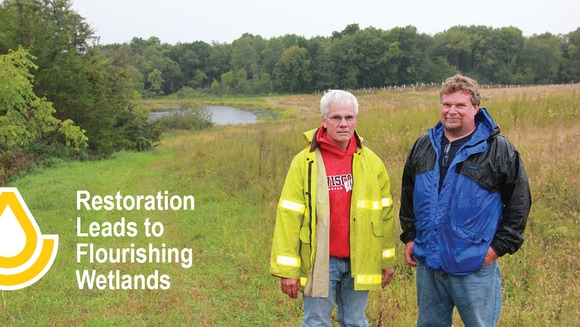Updated December 28, 2023
|
Oconto County: Storm Damage Rehabilitation Through Conservation
Wisconsin natural resource agencies team up to restore a family forestland after an “inland hurricane” threatens five generations of dedicated forest management with assistance from the Natural Resources Conservation Service Environmental Quality Incentives Program. Read More |
|
Vernon County: Ridgetop Farm Adopts Considerate Conservation Practices
Preserving the legacy of the land with consideration for the community through conservation practices, Highland Farm sets out to organically revitalize their ridgetop farming operation. Read More |
Updated October 2, 2023
|
Green Lake County: Community Supported Agriculture Growth Increases with High Tunnel
With almost a decade of focus on regenerative agriculture under their green thumbs, Mat & Dani of Boerson Farm utilized the Environmental Quality Incentives Program (EQIP) to build seasonal high tunnels that support a more abundant growing season for their Community Supported Agriculture operation. Read More |
|
Rock County: Recipes for Helping People Help the Land
For over 30 years, Gary and Penny Shackelford have been compiling a personalized “cookbook” of conservation practices with help from the Conservation Stewardship Program (CSP) in hopes to pass their not-so-secret recipes for conservation on to the future stewards of the land. Read More |
Updated August 31, 2023
|
Ozaukee County: Demo Farm Produces Next Generation of Caterpillar Caretakers
From learning-by-doing to shining example, father-and-son farming team Roger and Brian Karrels joined the Ozaukee Demonstration Farm Network in showcasing what conservation practices and welcoming vital pollinators can do for soil health and crop yields. Read More |
|
Washburn County: Culturally Informed Land Restoration
Inspired by the history of the land he stewards and driven by his desire to connect more deeply with his family’s traditional cultural relationships with the land, Damian Vraniak has worked for the past 30 years to restore the savanna and prairie land once owned by his grandfather with species that are of cultural significance to the stewards of the land who came before him. Read More |
Updated July 28, 2023
|
Fond du Lac County: Continuing a Legacy of Conservation
Legacy land stewards, John and Barb Floyd, honor the conservation ethics passed on by John’s parents, while continuing the work to leave their land even better for the next generation through the Conservation Stewardship Program. Read More |
Updated June 1, 2023
|
Chippewa County: Improving Agronomy through a Passion for Research
Jody Wilhelm’s experiments with on-field solutions to reduce cost of input for producers on her farm have naturally supported existing conservation practices. Thanks to the financial assistance provided by the Environmental Quality Incentives Program, Jody has been able to seed cover crops for ongoing evaluation and analysis. Read More |
|
Rusk County: Healthy Soil for the Farm’s Future
“The Conservation Stewardship Program really provided the incentives we needed to start incorporating more soil health practices into our cropping system,” Laurie Fortuna, 4th generation landowner, and her husband Larry make soil health their main mission on their 500-acre dairy farm. Read More |
Updated May 1, 2023
|
Clark County: Wetland Scrapes the Surface of Land Restoration Goals
Determined to restore her land to its original state, Carol Eloranta enrolled in the Conservation Stewardship Program to help create a thriving habitat for a diversity of animals and pollinator plants. Read More |
|
Brown County: Wildlife Habitat Meets the Bees Needs and More
With the help of NRCS through the Conservation Stewardship Program, retired Department of Natural Resources Engineer, James Crawford, and his wife Carol turned a Brown County derelict dairy farm into the ‘bee’s knees’ for pollinators to thrive. Read More |
|
Barron County: Creating Dynamic Wildlife Habitats
With the help of the Conservation Stewardship Program, Barron County landowner Terry Elwood turns his diverse Moose Ear Creek acreage into a habitat haven for pollinators and wildlife. Read More |
|
Iowa County: Forest Management Glow-Up for "Grandmother"
With the help of the Environmental Quality Incentives Program, Cathy Bleser and Dan Krunnfusz of Iowa County extend their passion for conservation stewardship on their remote Driftless Area property, affectionately nicknaming the oak trees they have worked to restore. Read More |
|
St. Croix County: Conservation Practices Produce Fresh Outcomes
In the true spirit of Community Supported Agriculture, Mike and Jodi Lenz’s veggie farm produces impressive yields in conservation, community benefits, and educational comradery with assistance from the Environmental Quality Incentives Program (EQIP). Read More |
|
Calumet County: The Power of Community and Conservation
Led by Calumet County landowner, Marvin Thiel, a neighborhood comes together in mission during times of social distance to rehabilitate a shared watershed with the help of the NRCS Environmental Quality Incentives Program (EQIP). Read More |
|
Portage County: Generational Conservation and an Educator's Lasting Impact Brothers, Bill and Tom Roth continue a farming legacy of tried-and-true conservation practices instilled by their father and nurtured by their college professor. Read More |
|
Vernon County: Life-long Learning Leads to Organic Outcomes
The love of learning and their family land led Vernon County’s Pamela and Alan Seelow to organic certification and setting up their family farm successors for continued success. Read More |
|
Price County: Stream Crossing Improves Ability to Manage Forest
Former Wisconsin Department of Natural Resources Forestry Technician, Roy Gilge, partnered with the Natural Resources Conservation Service to overcome a persistent roadblock, with help from his family, friends, and 5 different practices funded by the Environmental Quality Incentives Program, allowing for more successful forest management. Read More |
|
Winnebago County: Production Thrives Under Seasonal High Tunnel
Since Matt Wilson, a veteran and beginner farmer, partnered with the Natural Resources Conservation Service through the Environmental Quality Incentives Program to expand his growing season, he has paid that knowledge forward by hosting educational opportunities for other beginner landowners. Read More |
|
Oneida County: A Little Help Goes a Long Way For Wildlife
Landowner Robert “Bob” Wojtusik returned to his Oneida County roots with a passion for wildlife conservation. With the assistance of multiple agencies, and the Environmental Quality Incentives Program (EQIP) and Conservation Stewardship Program (CSP) through NRCS, Bob has transformed his property into a wildlife habitat haven. Read more (1.1 MB pdf) |
|
Walworth County: Retirement Leads Beginning Farmer to Greener Pastures
After a post-retirement career shift, beginning farmer, Keith Manssen, partnered with NRCS through the Environmental Quality Incentives Program (EQIP) to ensure his new beef grazing operation reached his conservation and land management goals from the start. Read more (1.24 MB pdf) |
|
Rock County: Grassed Waterways Help Control Soil Erosion
Like his father before, Dennis Green utilized the NRCS Environmental Quality Incentives Program to manage soil erosion with grassed waterways to continue conservation efforts on their family farm. Read more (1.3 MB pdf) |
|
Calumet County: From Family Farm to Wildlife Sanctuary
Ryan and Jessica Peterson converted part of their farmland to a protective habitat for dozens of waterfowl and other feathered to furry fauna with help from NRCS through the Conservation Reserve Program. Read more (6.3 MB pdf) |
|
Juneau County: Local Forester Makes Big Impact
Forester Lee Herek’s years of dedication to forest stewardship plan writing under the NRCS Environmental Quality Incentives Program has a lasting effect on dozens of local landowners’ wooded acres. Read more (1.54 MB pdf) |
|
Outagamie County: A New Beginning for Grandpa's Dairy
With the help of NRCS through the Environmental Quality Incentives Program, Hunter Strebig made his dreams of turning his grandfather's farm into a successful and sustainable beef cattle operation a reality. Read more (486 KB pdf) |
|
Vernon County: A Passion for Farming
Tom and Sharon Sharratt are true conservation stewards. With the assistance of NRCS through the Environmental Quality Incentives Program and the Regional Conservation Partnership Program, the Sharratt's have completed practices to help restore their land and address landscape concerns. Read more (2.3 MB pdf) |
|
Dunn County: Burning for Success
With cooperative assistance from the NRCS programs, Driftless Area Landscape Conservation Initiative, and WI Department of Natural Resources, the Thomas' prescribed burn plan brings new plant life to their land. Read more (344 KB pdf) |
|
Manitowoc County: Barn Fire Rallies New Partnerships When tragedy struck the Schroeder’s dairy operation, a multitude of NRCS Wisconsin staff and local neighboring farms came together to implement a plan and provide much-needed assistance. Read more (557 KB pdf) |
Updated May 26, 2022
|
Langlade County: Minimizing Fire Risk with Woody Residue Treatment
With help from the NRCS through the Environmental Quality Incentives Program and Conservation Stewardship Program, Chris Johnson implemented Woody Residue Treatment to reduce hazardous risks, and hopes to foster foundational building blocks for forestland regrowth. Read more (1.36 MB pdf) |
|
Waupaca County: Fun and Profitable Grazing
Rheta and Art Richardson partnered with NRCS through the Environmental Quality Incentives Program and Conservation Stewardship Program to continue the evolution of Solbakken Farm. Almost 100 years later, the farm has evolved from a wheat farm, to dairy, to a busy direct-marketing beef business with 215 grazing acres. Read more (1.01 MB pdf) |
Updated May 6, 2022
|
Chippewa County: Dedication to Conservation
Heather Flashinski and her husband, Mark, partnered with NRCS through the Environmental Quality Incentives Program and Conservation Stewardship Program, to install permanent fencing and an above-ground water system to establish their rotational grazing system. Read more (889 KB pdf) |
|
Dane County: Small, Diverse and Thriving Organic CSA
Kristen Kordet manages a small organic farm in the Town of Dunn. With the help of NRCS through the Environmental Quality Incentives Program, she has installed practices such as a micro-irrigation system and a seasonal high tunnel, to combat extreme weather events like drought and excessive rainfall. Read more (1.52 MB pdf) |
|
Pepin County: Conservation Programs Fulfilling a Life-Long Dream
Sally Farrar has successfully converted cropland on her farm to native prairie by working with NRCS to utilize both the Environmental Quality Incentives Program and the Conservation Stewardship Program. NRCS has helped her manage her land through prescribed burns and planting pollinator habitat. Read more (748 KB pdf) |
|
Crawford County: Expanding a Wildlife Paradise with Monarch Habitat
In partnership with the Farm Service Agency and the NRCS, brothers, Jeff and Dennis Lenzendorf, have converted cropland into native grasses and pollinator habitat through the Conservation Reserve Program and the Environmental Quality Incentives Program. Read more (435 MB pdf) |
|
Green Lake County: Best Management Practices to Benefit Bees and Brookies
With the help from local partners and the Environmental Quality Incentives Program through the NRCS, Margaret York successfully completed a streambank restoration project and 8.1 acres of pollinator planting. Read more (1.1 MB pdf) |
|
Pierce County: Medication for the Soul and Soil
Randy and Liz Mittag partnered with the NRCS through the Environmental Quality Incentives Program and the Conservation Reserve Program to convert 71.5 acres of green pasture to managed rotational grazing. Read more (1.1 MB pdf) |
Updated February 24, 2022
|
Barron County: Oak Direct Seeding Restores Storm-Damaged Forest
Severe storms damaged Rod Jorgenson's 120-acre forest in northern Wisconsin. He partnered with NRCS to restore his forest through the Environmental Quality Incentives Program. Read more (810 KB pdf) |
|
Burnett County: Managed Grazing Makes a Difference
Tim Bandoli owns and operates Bandoli Family Ranch and partnered with NRCS through the Environmental Quality Incentives Program to covert 55 acres of cropland to a prescribed grazing system. Read more (431 KB pdf) |
|
Marathon County: Beef, Bees, Bluebirds and Monarchs
Jeff Pawlowski manages his mix of rolling pasture, hayland and wooded acres with the help of NRCS through the Regional Conservation Partnership Program. He worked to build monarch habitat, plants trees and shrubs for wildlife and more. Read more (1.3 MB pdf) |
|
Iowa County: Fostering a Land Ethic on the Seven Springs Farm
Tom and Carol Foster partnered with NRCS through the Environmental Quality Incentives Program and Conservation Stewardship Program to restore their forested acres. They established a Forest Management Plan, installed forest trails and landings, and more. Read more (550 KB pdf) |
|
Oconto County: New Demonstration Farms Network Forms Along the Shores of Green Bay
A new demonstration farms network has been established to demonstrate and showcase conservation and soil health practices that work in Northeast Wisconsin to protect soil and water quality. Learn about the first field day that took place and more about the Network. Read more (695 KB pdf) |
|
Richland County: Clary Cattle and Conservation
Austin and Emma Clary partnered with NRCS through the Environmental Quality Incentives Program to convert land to managed rotational grazing and protect streambanks on their farm. Read more (659 KB pdf) |
|
Winnebago County: Buckthorn Wars
Eric Jones and his wife, Sandra, own a 160-acre forest and partnered with NRCS through the Environmental Quality Incentives Program to combat invasive species on their property. Read more (921 KB pdf) |
|
Rusk County: Where Wildlife and Farming Mix Earl Wadewitz and Jane Sorenson partnered with NRCS through a variety of programs to build habitat for wildlife on their grasslands, uplands and forested acres. Read more (661 KB pdf) |
|
Lafayette County: Herefords Have Good Disposition When There's No Erosion
Kevin Bennett owns and operates Sandy Rock Ranch, a Hereford cattle operation, in the heart of the Driftless. He partnered with NRCS through the Environmental Quality Incentives Program and Conservation Stewardship Program to address erosion on his fields and stream banks. Read more (1.1 MB pdf) |
|
Sauk County: The Green Fire Forty—Giving Back to the Land
Kathy and Bill Pielsticker, of Hillpoint, Wisconsin, wanted to give back to the land through conservation. They partnered with the Natural Resources Conservation Service and the Farm Service Agency to restore their prairie and woodland habitats. Read more (2.1 MB pdf) |
|
Shawano County: Brothers Working to Regenerate Woodlands
Brothers John and Jim Hanson, partnered with NRCS through the Environmental Quality Incentives Program to install conservation practices to regenerate their woodlands. Read more (1.5 MB pdf) |
|
Taylor County: Benefits Through Partnership
Klayton Kree, a new NRCS Soil Conservation Technician, learned on the job by working with landowners, like Doug Stanek, of Gilman, Wisconsin, to install and establish prescribed grazing practices on the land. Read more (376 KB pdf) |
|
Fond du Lac County: Forever Teaching, Forever Learning
Julie Fitzpatrick owns and operates 14 acres of pastureland and has always had a passion for learning and sharing conservation. She partnered with NRCS through the Environmental Quality Incentives Program and Conservation Stewardship Program to establish her rotationally-grazed sheep operation. Read more (618 KB pdf) |
|
Forest County: Northwoods Family Farm Goes Organic
Gerald Medow owns and operates Medow Farms Organic LLC, and produces USDA-certified organic beef, chickens, hay, small grains and honey on 400 acres. He partnered with NRCS to develop and implement a forest management plan, add wildlife habitat and other conservation practices. Read more (399 KB pdf) |
|
Brown County: Innovative Farmer Has Sights Set on Soil Health
Pat Kane, a seventh generation dairy farmer in Denmark, Wisconsin, partnered with NRCS to implement a variety of soil health practices on his farm. Read more to learn about the benefits he is seeing on his land through implementing conservation. Read more (541 KB pdf) |
|
Outagamie County: Pollinator Planting Blooms Throughout Growing Season
Gerry Mich owns a diverse farm with cropland, pasture and forest in northern Outagamie County, Wisconsin. Gerry partnered with NRCS to restore his acreage, combating invasive species and creating habitat for wildlife, monarchs and pollinators. Read more (638 KB pdf) |
|
Racine County: Cover Crops Success Cultivates Forest and Wildlife Conservation
Jeff Rice, a corn, soybean and wheat farmer in Racine County, Wisconsin, partnered with NRCS to try cover crops. His initial success encouraged further conservation efforts, installing additional practices on his farm fields and in his forests. Read more (772 KB pdf) |
|
Marathon County: The Evolution of a Conservation Farmer
Mark Easker, of Norrie Lake Dairy Farm, was interested in implementing soil health principles on his land to help protect it. Learn how he partnered with the NRCS to try cover crops and no-till through the Environmental Quality Incentives Program. Read more (968 KB pdf) |
|
Rusk County: Partnering for a Better Farm
Sherri and Dale Goss raise Hereford beef, ducks, chickens, guinea fowl and more. Learn how they partnered with the NRCS to implement soil health and pasture management practices on their land, including sharing their successes through public pasture walks. Read more (1.1 MB pdf) |
|
Sawyer County: Buckthorn Invasive Species Management
David Shadis cares for his grandfather's 275-acre forested property. Learn how he partnered with NRCS to complete invasive species management, combating the spread of buckthorn on the property. Read more (771 KB pdf) |
|
Chippewa County: Restoring Marginal Cropland Into a Waterfowl Refuge
Stanley Ewings, a dairy farmer in the heart of Chippewa County, Wisconsin, operates 360 acres of cropland. He partnered with NRCS through Wetland Reserve Easements to restore 67 acres back into a wetland and prairie habitat. Read more (2.4 MB pdf) |
|
Dodge County: The Definition of Innovators
Nancy Kavazanjian and Charlie Hammer operate 1,950 acres in Dodge County, Wisconsin. They partnered with both the NRCS and the Farm Service Agency (FSA) through the Conservation Stewardship Program and the Conservation Reserve Program to increase wildlife habitat and meet their conservation goals. Read more (765 KB pdf) |
|
Pierce County: Conservation Stewardship Program Success
John Robey and his wife, Monica, operate a diary farm in Elmwood, Wisconsin. They partnered with NRCS through the Conservation Stewardship Program to implement a diverse conservation crop rotation, mulch tillage, plant monarch habitat, and more. Read more (647 KB pdf) |
|
Grant County: Sixmile Habitat Success
Mary Stanek partnered with NRCS for the first time through the Regional Conservation Partnership Program to restore and protect her streambanks, add stream habitat structures and three wetland scrapes on her farm. Read more (581 KB pdf) |
|
Shawano County: Providing Beauty with Pollinator Habitat
Betley Farms LLC, contacted NRCS with an interest in the Conservation Stewardship Program. Through CSP, the family dairy farm added multi-species pollinator habitat to benefit monarchs, honey bees and other pollinator species. Read more (827 KB pdf) |
|
Winnebago County: Let the Cattle Take the Load Off
Gary and Terri Kenneth were inspired after attending an NRCS pasture walk to implement a rotational grazing system on their farm through the Environmental Quality Incentives Program. Read more (1.3 MB pdf) |
|
Douglas County: Bee Friendly Pollinator Planting
Paula Pedersen and Sara Thomsen partnered with NRCS to complete native pollinator plantings on their property. Learn how they are helping bees and other pollinators one acre at a time. Read more (848 KB pdf) |
|
Monroe County: Upward Trends in Soil Organic Matter Levels Through the Decades
The Kortbein family has been implementing conservation, with the help of NRCS, since the 1980s. Their increase in soil organic matter over time shows their commitment to soil health and sustainability. Read more (693 KB pdf) |
|
Brown County: Managing Land One Generation at a Time
Andy Vanderloop, of Greenleaf, wanted to manage his land in a more natural way. He partnered with the NRCS to develop a forest management plan, plant a multi-species pollinator mix, plant trees and shrubs for a variety of wildlife species, and more. Learn how Andy is making a conservation difference. Read more (763 KB pdf) |
|
Lafayette County: Flown-On Cover Crops Offer Potential Benefits
Larry Redfearn wanted to find new conservation solutions to protect his land from increasingly erosive rain events. Learn how he partnered with NRCS to aerial seed cover crops into standing corn and soybeans. Read more (1 MB pdf) |
|
Manitowoc County: Protecting Water Quality Through Leachate Collection
The Kocourek Bros. farm contacted NRCS with the need for proper containment of leachate runoff on their corn silage feed pad. Learn how NRCS partnered to install a leachate collection pond and subsurface drain to protect water quality. Read more (608 KB pdf) |
|
Oneida County:
Farming for Pollinators in the Northwoods Scarlet and John Sweeney partnered with NRCS through the Environmental Quality Incentives Program and the Conservation Stewardship Program to maximize food and habitat for honeybees, monarchs and other pollinators. Read more (432 KB pdf) |
|
Juneau County: Leading by Example, Outdoors Forever Conservation Club
The Outdoors Forever Conservation Club hosts a youth conservation day partnering with the NRCS Mauston Service Center to teach students about natural resources. The club also participates in the NRCS Conservation Stewardship Program and FSA's Monarch SAFE program. Read more (627 KB pdf) |
|
Door County: Raising Awareness for Soil Health
During the Door County Festival of Nature, participants were able to see the NRCS rainfall simulator in action at Brey Cycle Farm. Attendees learned the benefits of soil health practices on the land. Read more (529 KB pdf) |
|
Calumet County: Beginning Farmer, Big Success
Beginning Farmers Austin and Kristen Pethan partner with NRCS through the Environmental Quality Incentives Program and the Conservation Stewardship Program to help meeting their conservation goals. Read how they were able to write a grazing plan, plant permanent pasture, construct fence, install water lines and more. Read more (1 MB pdf) |
|
Dunn County: Practicing Water Quality Protection While Improving Return on Investment
Jeff and Kelley Lake's interest in soil and water led them to a partnership with NRCS. After successes with no-till, cover crops and more, the family worked with NRCS and Pheasants Forever to asses their farms overall profitability acre-by-acre. Recommended tweaks in their farming system improved their ROI. Learn how by reading more. Read more (331 KB pdf) |
|
Waupaca County: A Dedication to Conservation Farming
From grassed waterways and soil health techniques, to rotationally-grazed pastures and restoring wetlands, learn how Dan and Ruth Boerst are dedicated to improving their lands through a partnership with the NRCS. Read more (862 KB pdf) |
|
Lincoln County: Rejuvenation of a Family Farm
Beginning farmers Stacy and Scott Pettit, of Merrill, Wisconsin, partnered with NRCS to improve energy use efficiency, transition their farm to managed rotational grazing, rehabilitate their forested acres and increase wildlife habitat. Read more (952 KB pdf) |
|
Shawano County Youth Conservation Field Day
NRCS partnered with the Navarino Nature Center, in Shawano County, Wisconsin, to host a Youth Conservation Field Day. Participants learned about wetlands, soils, fisheries, wildlife, alternative energy, forestry, agriculture and more. Read more (663 KB pdf) |
|
Washington County: Cooperative Partnerships Lead to Conservation Success
Dan Stoffel, with his two brothers, operate Stoffel Grain Farms, Inc. in Washington County, Wisconsin. The Stoffels have been implementing conservation for as long as they can remember, no-tilling for 25 years. They partnered with NRCS through the EQIP and CSP for numerous practices to benefit their cropland and increase wildlife habitat. Read more (1 MB pdf) |
|
Green County: High School Students Learn About Soils
Future Farmers of America students from across Wisconsin competed in a local land judging contest to learn about soils and conservation practices. Read more (432 KB pdf) |
|
Crawford County: New Farmer Owners Make Big Changes
Jake and Marcie Connelly, of Soldiers Grove, had a mix of cropland and pastureland they were looking to start rotational grazing on. Through a partnership with NRCS and EQIP, they made their goals a reality. Read more (488 KB pdf) |
|
The Peasley family, of Black River Falls, operates a dairy farm that recently partnered with NRCS to implement managed rotational grazing. They also completed an Agricultural Energy Management Plan to identify improvements they could make on the farm to reduce the amount of energy used.
Read more (488 KB pdf) |
|
Marathon County: NRCS to the Rescue After Fire and Flood
NRCS staff have diverse backgrounds and experiences to offer when working with farmers and landowners. Meet Charles Schwartz, an NRCS Soil Conservation Technician, and learn how he, and others in similar USDA Service Center positions, can help meet your conservation goals. Read more (887 KB pdf) |
|
Wood County: Breu Farm Conservation Improvements Help Success Continue Into Future
The Breu family dairy completed many conservation improvements on their operation. Learn more about how they partnered with NRCS for nutrient management planning, installing underground outlets, roof gutters, a waste storage facility with fencing, waste transfer pipe and more. Read more (663 KB pdf) |
|
Columbia County: Returning Habitat to the Land
Jason Givens, owner and operator of Lighthouse Kennels, partnered with NRCS to create bird habitat on his property. Through the Conservation Stewardship Program, he planted seven acres using a diverse mix of trees and shrubs. Local populations of pheasants are now on the rise. Read more (567 KB pdf) |
|
Manitowoc County: Building a Wisconsin Dairy Herd with Pasture
Karl and Robert Klessig, fifth generation dairy farmers in Cleveland, Wisconsin, partnered with NRCS to set up a managed rotational grazing system. They installed fencing, planted high quality forages, improved trail and watering systems, and more. Read more (964 KB pdf) |
|
Rusk County: Growing Forest Products and Quality Wildlife Habitat
Steve Christianson manages a 200-acre forest parcel in northwest Rusk County. With the help of NRCS, he decided to manage his property for wildlife. Learn how Steve planted pollinator habitat and completed forest stand improvement to remove undesired species. Read more (798 KB pdf) |
|
Bayfield County: Creating Wetland Habitat at the Oulu Cultural and Heritage Center
Duane Lahti partnered with NRCS through the Great Lakes Restoration Initiative to restore wetland habitat on his property. The new wetlands are enabling the expansion of a nearby school districts summer science curriculum. Read more (1 MB pdf) |
|
Iowa County: Living Classroom Enhanced with Prescribed Burn
Roger and Janice Boettcher partnered with NRCS through the Conservation Stewardship Program to prepare a prescribed burn plan designed for their unique land needs. The Boettchers now host educational field days on the newly thriving habitat. Read more (753 KB pdf) |
|
Pepin County: Good News Farm "Rare but Well Done"
Gordon and Rose Riesgraf partnered with NRCS through the Environmental Quality Incentives Program and the Conservation Stewardship Program to install various conservation practices on their farm for prescribed grazing. Read more (1 MB pdf) |
|
Dodge County: Energy Conservation and Improved Herd Health
Nehls Brothers Farms, in Juneau, took advantage of the Agricultural Energy Initiative, partnering with the NRCS to conserve light energy. Replacing lights in their animal production areas resulted in a huge annual cost savings. Read more (528 KB pdf) |
|
Grant County: Generations of Conservation
Ken and Joanne Kunkel are growing generations of conservation through partnering with the NRCS and the FSA for many years, installing various conservation practices across their 2,000 acres. Read more (2 MB pdf) |
|
Winnebago County: Buser Cattle Ranch Builds Grazing Operation
John and Katie Buser moved from out west to Winnebago County, with the dream of running their own cattle ranch. They partnered with the NRCS through the Environmental Quality Incentives Program to set up a managed grazing operation. Read more (777 KB pdf) |
|
Fond du Lac County: Goats Suppress Weeds and Invasive Brush
Wayne Hass, of Eden, Wisconsin, is a shining example that you do not have to own a large plot of land to make a positive impact. See how he partnered with NRCS to install a seasonal high tunnel and participates in the Conservation Stewardship Program. Read more (909 KB pdf) |
|
Langlade County: Pasture Inter-Seeding and Rotational Grazing System—A Recipe for Improved Soil Health
Margaret Krause, of Rainbow's End Farm, in Antigo, Wisconsin, partnered with NRCS to set up a rotational grazing system through the Environmental Quality Incentives Program. She also hosts field days and pasture walks to share information and resources to farmers interested in setting up a rotational grazing system. Read more (258 KB pdf) |
|
Price County: Winter is for Tag Alder Shearing
Tood and Veronica Berg, of Minocqua, Wisconsin, partnered with NRCS and the American Bird Conservancy through the Regional Conservation Partnership Program to complete tag alder shearing, increasing wildlife habitat for song birds and other species like the golden-winged warbler. Read more (509 KB pdf) |
|
Official Web Soil Survey Available:
Soil Science Annual Data Refreshed Madison, Wis. – October 8, 2019 – The entire Web Soil Survey Database is refreshed each year in October to ensure that updated official data is available to the public for use in implementing national programs affecting landowners and managers. READ MORE |
The New NRCS Characterization
(Lab Data Map): Soil Data at Your Fingertips Madison, Wis. ‒ October 8, 2019 ‒ The NRCS in Wisconsin and the National Soil Survey Center have made available a new interactive map that allows users to search soil data at the local level. READ MORE |
|
Fond du Lac County: Small Farm Produces Big Conservation Results
Tracy and Richard Vinz, of Olden Produce LLC, work hard to produce heart healthy fruits and vegetables in their local community of Ripon. Learn how they extended their growing season by installing a high tunnel and other conservation with the help of NRCS. Read more (813 KB pdf) |
|
Monroe County: New Landowners Help Save Dam for Wildlife
Jennifer and her husband purchased land in Monroe County with a goal of expanding the wildlife value of the property. They partnered with NRCS to repair a dam on the acreage to benefit wildlife. Read more (647 KB pdf) |
|
Outagamie County: 26 Years of Sustainable Forest Management
Steve Ring, owner of Pinevilla Tree Farm near Shiocton works to actively manage his 175-acre woodlot. With the help of NRCS, he's creating early successional habitat, installed bat houses and completed various forest stand improvement practices. Read more (405 KB pdf) |
|
Adams County: Innovative Adoptions 'BeeCome' Pollinator Habitat
Wallendal Farms operates 3,300 acres in Grand Marsh, Wisconsin. The farm has a long history of innovative sustainable agriculture. Learn how, with the help of NRCS, the farm added habitat for pollinators and much more. Read more (214 KB pdf) |
|
Shawano County: 2nd Annual Queen Bee Event
The Natural Resources Conservation Service partnered with the Farm Service Agency, Pheasants Forever and UW-Extension to provide an opportunity for women landowners at Windswept Acres Specialty Cut Flowers. Learn more about the 2nd Annual Queen Bee Event and future events. Read more (211 KB pdf) |
|
Waupaca County: Building on a Family Conservation Ethic
Rachel Bouressa and her two children, Natalie and Crosby, live on the family farm near New London, Wisconsin. Conservation roots run deep in this farm. With the help of NRCS, Rachel converted cropland to pasture and installed fence and livestock pipeline. Learn more about how Rachel set up a grassed-based farming operation. Read more (222 KB pdf) |
|
Barron County: Impaired Lake Gets a Helping Hand
Duane and Nancy Kodesh operate a family dairy farm near Rice Lake, Wisconsin. They partnered with NRCS to develop a Comprehensive Nutrient Management Plan to alleviate leachate runoff on the farm. Read more about how they installed conservation practices to fix the issue. Read more (170 KB pdf) |
|
Kewaunee County: From Cropland to Wildlife Habitat
Tom and Renae Werner own land near Luxemburg, Wisconsin. Through a partnership with the NRCS and the Farm Service Agency, they restored their acreage to become a habitat oasis for wildlife. Read more (294 KB pdf) |
|
Racine County: Watershed Protection Committee
Racine County is home to a thriving producer-led committee with a goal of improving water quality throughout the county. Learn more about the growing group that is spreading conservation information across southeast Wisconsin. Read more (182 KB pdf) |
|
Buffalo County: Letting the Land Determine the Legacy
Larry and Jane Linse operate a 300-acre century farm just outside of Modena. The Linses worked with the Farm Service Agency and the NRCS to revitalize their land by stabilizing eroded streambanks, completing a prescribed grazing plan, interseeding pastures, planting pollinator habitat and much more. Read more (252 KB pdf) |
|
Burnett County: Wild Rice (Manoomin) Seeding
The St. Croix Chippewa Indians of Wisconsin focus on conservation activities and programs to ensure sound management of natural resources. The tribe recently partnered with NRCS to combat the decline of wild rice populations and help restore the traditional tribal crop through the Environmental Quality Incentives Program. Read more (168 KB pdf) |
|
Crawford County: It Takes a Village...
Meet Crawford County Conservationist Dave Troester and learn about an idea that grew into almost 4,000 acres of cover crops aerially applied in the county to increase soil health through partnerships. Read more (212 KB pdf) |
|
Brown County: Grazing to Improve Public Land Wildlife Habitat
Carl and Kathy Tennessen bought two beef cows at the request of their young daughter and sure enough, caught the hobby farm bug, adding more cows, chickens and rabbits. With the help of NRCS, read how they made grazing work on public land and also increased wildlife habitat at the same time. Read more (817 KB pdf) |
|
Calumet County: Partnership is Key to Success
Brothers, Joe and Don Geiser, and Don's son, Adam, were determined to address their nutrient management, environmental and farm management concerns brought on by their farmland’s karst topography. Read how the Geisers used cover crops, developed a nutrient management plan and more, with the help of NRCS. Read more (167 KB pdf) |
|
Marathon County: Finding "Common Ground"
Jason Cavadini is a soil health hero in his professional and personal life. As the Assistant Superintendent of the Marshfield Ag Research Center, Jason has been researching how the principals of soil health respond in the cool, wet soil of North Central Wisconsin. Read more about how Jason partners with NRCS to host soil health days and trainings and installed a prescribed grazing system. Read more (209 KB pdf) |
|
Columbia County: Wetland Management Landowner Workshop
The NRCS and the Wisconsin Wetlands Association partnered to hold a free workshop focusing on benefits of the NRCS Wetland Reserve Program for landowners. Read more (233 KB pdf) |
|
Polk County: "Farming Ugly" on the Field Can Pay Off
David Randall is not afraid to "farm ugly," leaving residue on his fields. With the help of NRCS, he's no-till planting, cover cropping, doing split nutrient applications, and more to improve his soil's health. Read more (826 KB pdf) |
|
Richland County: From Renter, to Steward of the Land
Steve Banker rents a farm house nestled high on a bank over looking Knapps Creek. After recent storm events, some of the banks highly eroded. With the help of NRCS, he was able to address the erosion issues and restore the stream. Read more (214 KB pdf) |
Farming Regeneratively
to Leave a Legacy
|
Meet Mark and Lucy Doudlah, farmers in Cooksville, Wisconsin, who produce 20 different crops and raise free-range, grass-fed meat using one guiding principle – being regenerative.
|
Ozaukee Demo Farm Field Day
Highlighting No-Till Planter Setup, Tips and Tricks
|
Madison, Wis –
Over 85 farmers and partners attended the first ever Ozaukee County Demo Farm field day on Wednesday, April 3, 2019. The NRCS and the Ozaukee County Land & Water partnered to develop and support the network of farms that are demonstrating the best conservation practices to reduce phosphorus entering Lake Michigan. Learn more about no-till planter setup and tune up by reading the full feature story. |
We celebrate by highlighting just a few of the farmers working hard to grow
food, fiber, and fuel for our nation and beyond. These farmers dedicate their
lives to providing for us all. Today and every day, join us in thanking them.
food, fiber, and fuel for our nation and beyond. These farmers dedicate their
lives to providing for us all. Today and every day, join us in thanking them.
Celebrating 25+ Years Restoring Wetlands
Did you know every year, Wisconsin NRCS wetland easements have the potential to remove over 56 million pounds of nitrogen and 730,000 pounds of phosphorous from urban and agricultural runoff? Wetland easements hold multiple benefits and we're celebrating them!
In Wisconsin, NRCS is celebrating over 25 years of working with private landowners across the state to restore and protect over 68,000 acres of wetlands and related habitats that deliver an array of ecosystem services for generations to enjoy.
In Wisconsin, NRCS is celebrating over 25 years of working with private landowners across the state to restore and protect over 68,000 acres of wetlands and related habitats that deliver an array of ecosystem services for generations to enjoy.
|
Grant County: Farm Bill Programs Assist in Habitat Restoration
Dan Bolin wanted to restore his acreage to native prairie, along with maintaining his woodlots for wildlife and production timber. Read how Dan partnered with USDA's NRCS and FSA to reach his land management goals. Read more (1.6 MB KB pdf) |
|
Trempealeau County: Partners for Pollinators
Dan and Lorraine Beck wanted to restore their land and also build pollinator habitat with a diverse mix of native forbs, legumes and grasses. Read how the USDA's NRCS and FSA partnered to transform the acreage. Read more (662 KB pdf) |
|
Winnebago County: Saving Energy Makes Sense for Hinz Farm LLC
Father-son duo, Mike and Dan, invested in their operation with the help of NRCS, assessing, planning and implementing practices that save them money and energy on the farm. Read more (195 KB pdf) |
Log-Grown Shiitake Mushrooms
Misty Dawn Farm Shares the Magic
|
Shiitakes and logs are two peas in a pod. When talking with Ingrid and Paul West, of Misty Dawn Farm in Stoughton, Wisconsin, you’ll certainly learn why. The Wests lovingly care for their harvested logs that produce homegrown shiitake mushrooms.
Learn how they partnered with NRCS to revitalize their forested acres and used their harvest to grow the healthy diet staple, a savory mushroom many can’t get enough of. |
|
Early Successional Habitat Development—Alder Shearing
In Ashland County, Steven and Debbie Thurber wanted to create better habitat for birds, deer and other wildlife on their property. They partnered with the NRCS through the Environmental Quality Incentives Program (EQIP) to restore their property. Read more (327 KB pdf) |
|
Eau Claire County: Restoring Wetlands
for Wildlife In Eau Claire County, William Connelly owns 311 acres and was interested in restoring and managing his land for wildlife habitat and water quality. He partnered wtih NRCS to restore his wetland and create pollinator-friendly habitat. Read more (222 KB pdf) |
|
Partnership Teaches Sustainable Practices and Resource Management
In Vilas County, NRCS partners with Trees for Tomorrow to provide students with hands-on field experiences in natural resources education. Read more (326 KB pdf) |

Wanting a Change...
In Jefferson County, Kirsten Jurcek worked with NRCS to implement a prescribed grazing plan through the Environmental Quality Incentives Program. She also enrolled in the Conservation Stewardship Program and established an agricultural conservation easement on her acreage.
Read more (208 KB pdf)
In Jefferson County, Kirsten Jurcek worked with NRCS to implement a prescribed grazing plan through the Environmental Quality Incentives Program. She also enrolled in the Conservation Stewardship Program and established an agricultural conservation easement on her acreage.
Read more (208 KB pdf)
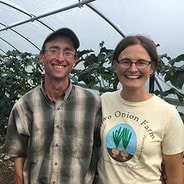
Making the Dream Come True
In Lafayette County, beginning farmers Caleb and
Eva worked with NRCS to install high tunnels and
micro-irrigation, while also converting a low production crop field to a rotationally grazed pasture for sheep.
Read more (698 KB pdf)
In Lafayette County, beginning farmers Caleb and
Eva worked with NRCS to install high tunnels and
micro-irrigation, while also converting a low production crop field to a rotationally grazed pasture for sheep.
Read more (698 KB pdf)

Positive Steps Towards Energy Conservation
In Price County, United Pride Dairy partnered with NRCS through the Environmental Quality Incentives Program (EQIP) to develop a comprehensive nutrient management plan. They also enrolled in EQIP to replace lighting through the On Farm Energy Initiative.
Read more (169 KB pdf)
In Price County, United Pride Dairy partnered with NRCS through the Environmental Quality Incentives Program (EQIP) to develop a comprehensive nutrient management plan. They also enrolled in EQIP to replace lighting through the On Farm Energy Initiative.
Read more (169 KB pdf)
Fridays On The Farm:
The Proof Is in the SoilThis Friday, meet Derek Van De Hey, one of six northeast
Wisconsin farmers participating in a project that’s demonstrating how cutting-edge
conservation practices – like no-till and cover crops – are reducing agriculture’s impact
on water quality in Lake Michigan. At the same time, these practices are
leading to improvements for Van De Hey’s farm operation, too.
The Proof Is in the SoilThis Friday, meet Derek Van De Hey, one of six northeast
Wisconsin farmers participating in a project that’s demonstrating how cutting-edge
conservation practices – like no-till and cover crops – are reducing agriculture’s impact
on water quality in Lake Michigan. At the same time, these practices are
leading to improvements for Van De Hey’s farm operation, too.
CWD Spreads on Deer
|
|
Beginning Farmer Builds Habitat and Soil Health Through Prescribed Grazing
In Chippewa County, beginning farmers Ryan and Emily Anderson wanted to build habitat for grassland birds and beneficial pollinators, while also working on their soil's health. The Andersons achieved this goal by partnering with NRCS to install and implement a rotational grazing system. Read more (507 KB pdf) |
|
Nonpoint Source Success: Restoration of Pleasant Valley Branch Through Stream Corridor Rehabilitation In Dane County, multiple conservation partners worked together to restore the Pleasant Valley Branch of streams located in the Gordon Creek Watershed to benefit wildlife habitat and coldwater native fish species. Over 2 miles of stream was restored to decrease sediment inputs and improve riparian corridors and habitat, while also addressing nonpoint source issues. Read more (212 KB pdf) |
|
Healthy Soil Provides Numerous Benefits
In Manitowoc County, Matt Rataczak, NRCS District Conservationist, discusses the numerous benefits of healthy soil and what farmers can do to join in on the movement by implementing principles like no-till and cover crops on their farm. Read more (285 KB pdf) |

In Wisconsin's Great Lakes Region, New Horizons Dairy, a Fox Demo Farm, thrives through focusing on conservation that is environmentally sound and profitable. Read how the farm partners with NRCS through the Great Lakes Restoration Initiative to try different multi-species cover crops, maximizing their soil's health.
_________________________________
What is the first impression you get when looking at our earth and soil? Many would answer, its color. Vivid colors and striking differences in soil can catch one’s eye. Soil colors can help us predict mineral content, chemical composition, physical properties and other important natural resource characteristics.
Wisconsin state parks and forests feature a variety of diverse landscapes and soils. Click the link below to see highlights of state park and forest soils, compare them to your local soils, and learn how the USDA Natural Resources Conservation Service is using soil colors to help farmers understand their most important resource.
Wisconsin state parks and forests feature a variety of diverse landscapes and soils. Click the link below to see highlights of state park and forest soils, compare them to your local soils, and learn how the USDA Natural Resources Conservation Service is using soil colors to help farmers understand their most important resource.
|
In Sauk County, Conservation Observance Day was held to recognize the Yanke Family, of Echo-Y Farms, for their outstanding achievements in protecting and enhancing our state's natural resources. Read about the day and check out a video highlight featuring conservation practices on the farm.
Read more (260 KB pdf) Video Highlight (YouTube) |
|
In Dunn County, Jason and Melissa Schutz own and operate a beef farm nestled in a peaceful valley with springs feeding Annis Creek, a class one trout stream. The Schutzs wanted to improve their farm efficiency while also improving their water quality. Read how they partnered with NRCS through the Environmental Quality Incentives Program to install a new watering facility.
Read more (870 KB pdf) |
|
In Juneau County, the Ho-Chunk Nation wanted to restore a 272-acre native upland and wetland habitat. Partnering with NRCS, the tribe was able to stabilize over 2,500 feet of streambank, restore a 41-acre prairie, install a stream crossing, and more. Read how the tribe successfully restored their property through the Environmental Quality Incentives Program.
Read more (260 KB pdf) |

In Eau Claire County, Mary E. Fitz Memorial Park Trust and Landmark Conservancy partnered with NRCS to create a place of conservation for the enjoyment of the citizens of Eau Claire. Find out how they partnered to restore grasslands through the NRCS Environmental Quality Incentives Program.
Read more (219 KB pdf)
Read more (219 KB pdf)
|
In Green County, a single engine crop duster dropped thousands of pounds of cover crop seeds on fields of corn and soybeans as they began to ripen, just weeks ahead of fall harvest. Find out how this was made possible through the financial and technical assistance of the NRCS Environmental Quality Incentives Program.
Read more (399 KB pdf) |
|
In Iowa County, David and Diane Anderson are avid birding enthusiasts and conservationists. Find out how they worked with NRCS through the Environmental Quality Incentives Program and the Conservation Stewardship Program to benefit their grazing acreage while also planting perennial vegetation for grassland bird species.
Read more (174 KB pdf) |
Wisconsin Reservation Offers A Climate
Success Story And A Warning

When Star Ames was a child there was a flood. The streets were like rivers and the houses like islands. It was 1960 and the village of Odanah, Wis. was up to its neck.
The town had been built on the banks of the Bad River, in the floodplain. "I remember watching the river come up," Ames says. "Every place we thought was high enough, the water kept coming up."
Odanah was home to thousands of members of the Bad River Band of the Lake Superior Chippewa Tribe, and, as the water rose, people were trapped. "My dad went house to house in a boat and evacuated people," Star remembers, "taking people out through their second story windows."
Star Ames lives on the Bad River Reservation in northern Wisconsin. Her father was the longtime tribal chairman for the Bad River Band of the Lake Superior Chippewa Tribe, and helped instigate the relocation of the town of Odanah. Joe Proudman/UCDavis
Ames' father, Donald, was the tribal chairman at the time. "What I remember the most about [the flood] was that my father was really frustrated that they couldn't move," says Ames. "He wanted to move the village."
After the big flood in 1960, Ames set out to move thousands of Odanah residents to higher ground. In 1963, the Bad River Housing Authority was established and a couple years later the first displaced families moved into new houses — some of them federally subsidized single-family homes, most of them duplex rentals — a few miles up the highway.
It was the beginning of a monumental shift in life on the reservation. In the three decades or so after the 1960 flood, waves of people moved out of the flood plain until virtually the entire town had relocated to higher ground.
The timing could hardly have been better. At the same time that Odanah was moving, climate change was beginning to affect the region, increasing the risk of catastrophic floods. In the end, and largely by accident, Odanah became an early example of one of the most controversial options for a community trying to cope with climate change: retreating altogether.
The great unknown relocation
Nicholas Pinter first heard about Odanah a few year ago, and immediately wondered why he hadn't heard about it before.
Pinter, a geologist at the University of California, Davis, studies floods — where they happen and how humans deal with them. He's particularly interested in places where repeated, severe floods have forced entire towns to move. So-called managed retreat is a hot topic as climate change drives global sea level rise and more frequent and severe rainstorms in many parts of the country.
It's perhaps the most drastic of the many ways a town can deal with flooding. Upgrading drainage systems, raising buildings and building sea walls don't require people to leave their homes. Nonetheless, for some communities, complete relocation appears to be the best option.
"The U.S. is, right now, spending tens of millions and may in the future be spending hundreds of millions of dollars on managed treat, on community relocation," says Pinter. "They should be looking to the lessons of history."
Pinter is studying multiple towns, hoping to provide some of those historical lessons about how and why towns move out of harm's way.
The town had been built on the banks of the Bad River, in the floodplain. "I remember watching the river come up," Ames says. "Every place we thought was high enough, the water kept coming up."
Odanah was home to thousands of members of the Bad River Band of the Lake Superior Chippewa Tribe, and, as the water rose, people were trapped. "My dad went house to house in a boat and evacuated people," Star remembers, "taking people out through their second story windows."
Star Ames lives on the Bad River Reservation in northern Wisconsin. Her father was the longtime tribal chairman for the Bad River Band of the Lake Superior Chippewa Tribe, and helped instigate the relocation of the town of Odanah. Joe Proudman/UCDavis
Ames' father, Donald, was the tribal chairman at the time. "What I remember the most about [the flood] was that my father was really frustrated that they couldn't move," says Ames. "He wanted to move the village."
After the big flood in 1960, Ames set out to move thousands of Odanah residents to higher ground. In 1963, the Bad River Housing Authority was established and a couple years later the first displaced families moved into new houses — some of them federally subsidized single-family homes, most of them duplex rentals — a few miles up the highway.
It was the beginning of a monumental shift in life on the reservation. In the three decades or so after the 1960 flood, waves of people moved out of the flood plain until virtually the entire town had relocated to higher ground.
The timing could hardly have been better. At the same time that Odanah was moving, climate change was beginning to affect the region, increasing the risk of catastrophic floods. In the end, and largely by accident, Odanah became an early example of one of the most controversial options for a community trying to cope with climate change: retreating altogether.
The great unknown relocation
Nicholas Pinter first heard about Odanah a few year ago, and immediately wondered why he hadn't heard about it before.
Pinter, a geologist at the University of California, Davis, studies floods — where they happen and how humans deal with them. He's particularly interested in places where repeated, severe floods have forced entire towns to move. So-called managed retreat is a hot topic as climate change drives global sea level rise and more frequent and severe rainstorms in many parts of the country.
It's perhaps the most drastic of the many ways a town can deal with flooding. Upgrading drainage systems, raising buildings and building sea walls don't require people to leave their homes. Nonetheless, for some communities, complete relocation appears to be the best option.
"The U.S. is, right now, spending tens of millions and may in the future be spending hundreds of millions of dollars on managed treat, on community relocation," says Pinter. "They should be looking to the lessons of history."
Pinter is studying multiple towns, hoping to provide some of those historical lessons about how and why towns move out of harm's way.
Some places have already gotten attention for relocating, such as Valmeyer, Ill., which moved after a huge Mississippi River flood in 1993, and Staten Island's Oakwood Beach, which retreated after Hurricane Sandy.
"Odanah was the great unknown relocation," Pinter says. The town wasn't moving because of climate change, per se, but as people moved out of the flood plain, rainstorms were getting more frequent and severe. There have been multiple major floods in the region in recent years, culminating in a 2016 deluge that led the governor of Wisconsin to declare a state of emergency.
"In a way, Odanah was very successfully moved right before the monster flood, the 2016 flood, came through. That saved many hundreds of structures from potential flood damage," says Pinter. But exactly how many buildings were saved is more difficult to calculate. Pinter and James Rees, a student at the University of California, Davis, are combining old maps with satellite data and laborious in-person counting to figure out the answer.
"It takes a lot of work, but we'll be able to estimate how much damage would have occurred in 2016 if this town hadn't moved before that flood happened," explains Rees.
"Odanah was the great unknown relocation," Pinter says. The town wasn't moving because of climate change, per se, but as people moved out of the flood plain, rainstorms were getting more frequent and severe. There have been multiple major floods in the region in recent years, culminating in a 2016 deluge that led the governor of Wisconsin to declare a state of emergency.
"In a way, Odanah was very successfully moved right before the monster flood, the 2016 flood, came through. That saved many hundreds of structures from potential flood damage," says Pinter. But exactly how many buildings were saved is more difficult to calculate. Pinter and James Rees, a student at the University of California, Davis, are combining old maps with satellite data and laborious in-person counting to figure out the answer.
"It takes a lot of work, but we'll be able to estimate how much damage would have occurred in 2016 if this town hadn't moved before that flood happened," explains Rees.

Mike LaGrew explains where people lived along the banks of the Bad River in Old Odanah. Scientists trying to understand and quantify the effects of the town's move are using everything from hand-drawn maps to satellite images in their analysis.
Joe Proudman/UC Davis
Joe Proudman/UC Davis
The team hopes that putting hard numbers to damage avoided will be helpful for governments in other places that are trying to make similar decisions, weighing the costs of moving against the potential for future catastrophe. Long-term risks are notoriously difficult for local governments to plan for, and this is especially true for disasters like floods, which have a low likelihood of happening in any given year.
For that reason, moving out of the flood plain before the big flood is almost unheard of, which is what makes Odanah exciting.
"I don't want to tell them what their narrative is, but from an outside perspective, you had a relocation very well-timed," says Pinter. "It's usually right after a major flood. Here the real monster, in terms of quantity of water, came through after the relocation."
But that's not how it feels to some people on the Bad River Reservation.
Forced relocation
This is not the first time the people of Bad River have had to move. In fact, the tribe's existence in Wisconsin is itself the result of a relocation.
Odanah's original spot in the flood plain was chosen, as the oral history goes, by Ojibwe people from Maine. Driven west by invading Europeans, they eventually found a place where food grew on water. The food was wild rice and the water was the Bad River, where it flows into Lake Superior.
In 1854, the Bad River Band signed a treaty with the federal government to control about 125,000 acres of land, with Odanah at its heart. People still bring up the move, and the treaty, in conversation today.
And there was another, more recent relocation, also demanded by the federal government. In 1956, Congress passed what was known as the Indian Relocation Act, with the goal of cutting off support for American Indian tribes. The act created incentives for people living on reservations to move away from their allotted land and into cities.
For that reason, moving out of the flood plain before the big flood is almost unheard of, which is what makes Odanah exciting.
"I don't want to tell them what their narrative is, but from an outside perspective, you had a relocation very well-timed," says Pinter. "It's usually right after a major flood. Here the real monster, in terms of quantity of water, came through after the relocation."
But that's not how it feels to some people on the Bad River Reservation.
Forced relocation
This is not the first time the people of Bad River have had to move. In fact, the tribe's existence in Wisconsin is itself the result of a relocation.
Odanah's original spot in the flood plain was chosen, as the oral history goes, by Ojibwe people from Maine. Driven west by invading Europeans, they eventually found a place where food grew on water. The food was wild rice and the water was the Bad River, where it flows into Lake Superior.
In 1854, the Bad River Band signed a treaty with the federal government to control about 125,000 acres of land, with Odanah at its heart. People still bring up the move, and the treaty, in conversation today.
And there was another, more recent relocation, also demanded by the federal government. In 1956, Congress passed what was known as the Indian Relocation Act, with the goal of cutting off support for American Indian tribes. The act created incentives for people living on reservations to move away from their allotted land and into cities.
"They gave them a bus ticket, an apartment. Who wouldn't want that?" explains tribal historian Edith Leoso. Her own mother moved to Chicago in that period, around the same time that Odanah was beginning to relocate.
Many people who moved as a result of the Indian Relocation Act describe feeling displaced. In some parts of the country, entire tribes collapsed as the federal government ordered tribal governments to dissolve, and it became financially impossible for families to stay on their land.
This is the context in which Odanah began moving after the flood of the 1960. "I am a product of relocation," says Leoso. When she thinks about the town's move out of the flood plain and onto higher ground, she sees the latest example of federal government interference.
"It's just being forced to move," says Leoso. "It was a forced relocation, essentially. It wasn't something that we wanted to do. And that's something we've been forced to do all along."
Pinter says the side-by-side economic success and apparent cultural failure of the Odanah relocation is a wake-up call for federal and local governments. Native communities are disproportionately affected by climate-related flooding, in part because of that very same history of pushing Native peoples onto marginal land. Right now, the federal government is working on plans to move Native American towns in Alaska, Louisiana and elsewhere.
Even if those moves go smoothly from a technical standpoint, Odanah shows how they could potentially bring up a painful past.
"You know, you can draw a plan for a new town on the back of a napkin. That doesn't mean it's going to be a functional blueprint for a place that people can live in," says Pinter. "One of the things we've learned is that there are unique challenges in a Native American community, and, given that some of the headline relocation sites are Native American communities right now, they absolutely should be visiting Odanah and talking to the people here."
Many people who moved as a result of the Indian Relocation Act describe feeling displaced. In some parts of the country, entire tribes collapsed as the federal government ordered tribal governments to dissolve, and it became financially impossible for families to stay on their land.
This is the context in which Odanah began moving after the flood of the 1960. "I am a product of relocation," says Leoso. When she thinks about the town's move out of the flood plain and onto higher ground, she sees the latest example of federal government interference.
"It's just being forced to move," says Leoso. "It was a forced relocation, essentially. It wasn't something that we wanted to do. And that's something we've been forced to do all along."
Pinter says the side-by-side economic success and apparent cultural failure of the Odanah relocation is a wake-up call for federal and local governments. Native communities are disproportionately affected by climate-related flooding, in part because of that very same history of pushing Native peoples onto marginal land. Right now, the federal government is working on plans to move Native American towns in Alaska, Louisiana and elsewhere.
Even if those moves go smoothly from a technical standpoint, Odanah shows how they could potentially bring up a painful past.
"You know, you can draw a plan for a new town on the back of a napkin. That doesn't mean it's going to be a functional blueprint for a place that people can live in," says Pinter. "One of the things we've learned is that there are unique challenges in a Native American community, and, given that some of the headline relocation sites are Native American communities right now, they absolutely should be visiting Odanah and talking to the people here."
Highlights from the Summer Field Day 2018
The Lower Fox Demonstration Farms Network (Fox Demo Farms) is a Great Lakes Restoration Initiative project designed to showcase and demonstrate leading edge conservation practices that improve Great Lakes water quality by reducing phosphorus from entering Green Bay and Lake Michigan. See VIDEO HIGHLIGHTS of our summer field day featuring soil health practices, like no-till and cover crops, manure application methods, and much more!
The partnership is the first of its kind in the Great Lakes region and it consists of eight producers within the Fox River Basin, their crop consultants, Brown and Outagamie County Land and Water Conservation Departments, the Natural Resource Conservation Service (NRCS), and the University of Wisconsin-Extension.
The partnership is the first of its kind in the Great Lakes region and it consists of eight producers within the Fox River Basin, their crop consultants, Brown and Outagamie County Land and Water Conservation Departments, the Natural Resource Conservation Service (NRCS), and the University of Wisconsin-Extension.
USDA will invest more than $10.6 million for 22 new projects that will drive public and private sector innovation in conserving natural resources in 27 states, including Wisconsin. The competitive Conservation Innovation Grants program helps spur development and adoption of new conservation approaches and technologies.
July, 2018
|
The Driftless Area is a natural resource treasure, providing habitat for a myriad of animals and fertile land for farmers, ranchers and foresters.
When erosion on the steep slopes of the region threatened habitat, water quality and farms' productivity, NRCS and producers came together to help protect this unique region. Click on the DRIFTLESS AREA button for more. |
A Healthy Soil System
Building Organic Matter
Madison, Wis. – May 10, 2018 – The Door-Kewaunee Demonstration Farms Network is working to implement best management practices to reduce soil erosion and phosphorus runoff, increase soil organic matter and improve soil health. One of the primary indicators of a healthy soil system is its organic matter content. Learn how you can increase organic matter in your soils by building a healthy soil system and sign up to receive updates to attend future "Field Days on the Fly."
Building Organic Matter
Madison, Wis. – May 10, 2018 – The Door-Kewaunee Demonstration Farms Network is working to implement best management practices to reduce soil erosion and phosphorus runoff, increase soil organic matter and improve soil health. One of the primary indicators of a healthy soil system is its organic matter content. Learn how you can increase organic matter in your soils by building a healthy soil system and sign up to receive updates to attend future "Field Days on the Fly."
|
A HEALTHY SOIL SYSTEM
|
Success Story Highlights - Annual Report
In the Annual Report, you will see snapshots of NRCS Wisconsin’s approach in getting conservation practices on the ground to use our land productively, now and for future generations. You’ll learn about our program and outreach successes, along with highlights of the work we do, which is strongly focused on meeting Farm Bill responsibilities in a cost-effective, timely and accountable manner.
Read the Annual Report
June, 2018
|
In Fond du Lac County, Hiemstra Dairy worked with NRCS to improve water quality by working on their farm's soil health. Read about the conservation steps Josh and his family took on their farm to help improve the Upper Rock River watershed.
Read more (225 KB pdf) |
|
In Kewaunee County, Jennifer Graefe installed a seasonal high tunnel with the help of NRCS to support her local community with fresh vegetables. Graefe is also planting six acres to benefit pollinators.
Read more (225 KB pdf) |
|
In Vernon County, Kevin and Carolyn Parr, of Harmony Hills Farms, converted cropland to rotationally grazed pasture to better meet their farming needs and goals. The transition helps conserve their soil and provides ample forage for their cattle in the process.
Read more (149 KB pdf) |
May, 2018
|
In Marinette County, beginning farmers, Aaron and Erin Pape, worked with NRCS to start a rotational grazing operation. Read more about the materials and plantings used to meet their goals.
Read more (1 MB pdf) |
|
In Sheboygan County, learn about Almeta Farms and their deep roots in conservation. Through implementing a conservation plan and installing practices, they are meeting their goal of leaving a legacy for the next generation, making the farm more productive and healthier than when they started.
Read more (1 MB pdf) |
|
In Taylor County, Allen and Karen Swoboda run a dairy farm with 60 cows. With the help of NRCS, they were able to upgrade their existing barnyard to control runoff. Learn more about the conservation practices installed to assess their resource concerns, while improving water quality and animal health.
Read more (1 MB KB pdf) |
April, 2018
|
In Brown County, Jim Crawford and his wife, Carol, partnered with NRCS to restore pastureland for their sheep operation, while also creating more wildlife habitat and positively impacting the area watershed.
Read more (1 MB pdf) |

In Fond du Lac County, the Bord family has implemented various conservation practices to protect the land they operate and meet their bottom line. See how this former dairy operation transitioned to make their farm work.
Read more (149 KB pdf)
Read more (149 KB pdf)
|
In Washburn County, the Dahlstrom family has partnered with NRCS for over 40 years as good land stewards. Recently, Wayne and Jackie revitalized their 1,425-acre dairy and beef cattle operation by installing a variety of conservation practices.
Read more (164 KB pdf) |
|
Help us celebrate conservation farmers, like Jacob Marty, a beginning farmer working with NRCS to build a regenerative grazing operation in Monticello, Wisconsin.
“My livestock are managed in ways that mimic their natural history and behavior. This results in healthy and happy animals that produce quality meat in the process.” -Jacob |
March, 2018
|
In Lafayette County, Two Onion Farms is working to build layers of conservation on their operation! Learn more about how this organic fruit and vegetable farm partnered with NRCS to extend their growing season with a seasonal high tunnel.
Read more (140 KB pdf) |
|
In Pierce County, Huber Farms Inc, has made a major shift in the past few years, selling the dairy herd, changing crop rotations, planning nutrient management, starting no-till and cover crops, and more. Learn more about how they revitalized their operation by keeping calm and farming on, with the help of NRCS.
Read more (596 KB pdf) |
|
In Sauk County, the Millers partnered with NRCS and the local conservation district to make conversion to prescribed grazing work on their farm. Learn more about how they installed livestock pipeline, fencing, grassed waterways and did forage and biomass plantings, converting 230 acres to prescribed grazing.
Read more (173 KB pdf) |
February, 2018
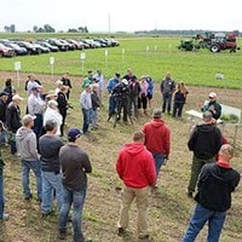
In Green County, cooperative conservation contributes to cleaner water through the National Water Quality Initiative. Learn more about the 6-year effort involving various partners and landowners to install over 130 best management practices in Green Lake Watershed.
Read more (356 KB pdf)
Read more (356 KB pdf)

In Jackson County, healthy soil principles and the importance they play on pollinator habitat is a key focus at the county fair. Learn more about soil profiles and find out which Wisconsin soils were showcased.
Read more (272 KB pdf)
Read more (272 KB pdf)

In Lincoln County, a longer growing season is a win-win for this producer. Learn more about Farmer Don Nichols and how he installed a seasonal high tunnel to plant various fruits and vegetables.
Read more (223 KB pdf)
Read more (223 KB pdf)
|
Meet Wisconsin's very own Richard DeWilde, of Harmony Valley Farm in Vernon County. His passion for healthy soil and growing organic food has led to a thriving organic community and happy consumers. Helping People Help the Land www.wi.nrcs.usda.gov |
January, 2018

Bayfield County: Gaining Ground with an Innovative Asphalt Cattle Lot
Larry Ekholm runs a small beef farm and has been grazing cattle on heavy clay soils for many years. Ekholm worked with NRCS to transform his cattle operation by remodeling two barn lots and creating vegetative filtration areas. He also installed an asphalt lot, one of the first of its kind in the area.
Read more (289 KB pdf)
Larry Ekholm runs a small beef farm and has been grazing cattle on heavy clay soils for many years. Ekholm worked with NRCS to transform his cattle operation by remodeling two barn lots and creating vegetative filtration areas. He also installed an asphalt lot, one of the first of its kind in the area.
Read more (289 KB pdf)

Crawford County: 58 Years of Conservation and Counting
John and Norma Gillitzer, of Star Acres LLC, have been applying conservation on their land since they bought it in 1959. The Gillitzers worked with NRCS to fix soil erosion issues and combat gully erosion. They installed grade stabilization structures through EQIP.
Read more (304 KB pdf)
John and Norma Gillitzer, of Star Acres LLC, have been applying conservation on their land since they bought it in 1959. The Gillitzers worked with NRCS to fix soil erosion issues and combat gully erosion. They installed grade stabilization structures through EQIP.
Read more (304 KB pdf)
|
Polk County: Partnership Fulfills Woodland Niche
NRCS, the Ruffed Grouse Society and the Wisconsin Department of Natural Resources formalized a partnership to provide funding for a new Forest Wildlife Specialist position. The partnership position focuses on young forest habitat in Northwestern Wisconsin, providing assistance to private landowners to develop sound forestry practices on their properties. Read more (122 KB pdf) |
New Video!
Soil Health Benefits
Green Lake Area Conservation Field Day Success
Learn in this NEW feature video, about how improving your soil’s health is good for your farm, your yields and good for water quality downstream. Take a virtual tour with us at the first annual Green Lake Area Conservation Field Day. See our rainfall simulator in action, learn about the principles of soil health and see the impact they can make through a soil pit demonstration. Hear from Green Lake Association’s Executive Director about how partnership efforts in the community are making a difference in Green Lake watershed’s water quality.
Green Lake Area Conservation Field Days are a partnership effort between local farmers, Green Lake Association, Natural Resources Conservation Service (NRCS), Green Lake County Land Conservation Department, Ripon FFA, UW-Extension, Green Lake County Farm Bureau and many volunteers. For more information about soil health and assistance available for farmers to implement conservation practices, visit www.wi.nrcs.usda.gov or contact your local NRCS service center.
Soil Health Benefits
Green Lake Area Conservation Field Day Success
Learn in this NEW feature video, about how improving your soil’s health is good for your farm, your yields and good for water quality downstream. Take a virtual tour with us at the first annual Green Lake Area Conservation Field Day. See our rainfall simulator in action, learn about the principles of soil health and see the impact they can make through a soil pit demonstration. Hear from Green Lake Association’s Executive Director about how partnership efforts in the community are making a difference in Green Lake watershed’s water quality.
Green Lake Area Conservation Field Days are a partnership effort between local farmers, Green Lake Association, Natural Resources Conservation Service (NRCS), Green Lake County Land Conservation Department, Ripon FFA, UW-Extension, Green Lake County Farm Bureau and many volunteers. For more information about soil health and assistance available for farmers to implement conservation practices, visit www.wi.nrcs.usda.gov or contact your local NRCS service center.
New Video! Partnership Efforts Improve Great Lakes Water Quality
Featuring the Lower Fox Demonstration Farms Network
Members of the Lower Fox Demo Farms Network (Fox Demo Farms) are working to restore our natural resources through conservation, so future generations can continue the tradition of sustainable agriculture in northeast Wisconsin. Hear their stories and realize their results in this New Feature Video. Help us share and support their tremendous efforts.
The Fox Demo Farms is a Great Lakes Restoration Initiative project designed to showcase and demonstrate leading edge conservation practices that improve Great Lakes water quality by reducing phosphorus from entering Green Bay and Lake Michigan.
The partnership is the first of its kind in the Great Lakes region, consisting of six producers, their crop consultants, the USDA Natural Resources Conservation Service, Brown and Outagamie County Land and Water and University of Wisconsin-Extension. For more information on this partnership effort or to attend an upcoming field day, visit www.foxdemofarms.org and follow us on Facebook and Twitter.
Featuring the Lower Fox Demonstration Farms Network
Members of the Lower Fox Demo Farms Network (Fox Demo Farms) are working to restore our natural resources through conservation, so future generations can continue the tradition of sustainable agriculture in northeast Wisconsin. Hear their stories and realize their results in this New Feature Video. Help us share and support their tremendous efforts.
The Fox Demo Farms is a Great Lakes Restoration Initiative project designed to showcase and demonstrate leading edge conservation practices that improve Great Lakes water quality by reducing phosphorus from entering Green Bay and Lake Michigan.
The partnership is the first of its kind in the Great Lakes region, consisting of six producers, their crop consultants, the USDA Natural Resources Conservation Service, Brown and Outagamie County Land and Water and University of Wisconsin-Extension. For more information on this partnership effort or to attend an upcoming field day, visit www.foxdemofarms.org and follow us on Facebook and Twitter.
December, 2017
Madison, Wis. – December 21, 2017 – Welcome to the December edition of Successes from the Field!
|
Pepin County: A Prairie Christmas, Beauty in the Bloom
Brent and Christine Bauer own a 93 acre farm near Durand, Wis. The Bauers worked with NRCS and FSA to restore the acres to their original native condition. Find out how Wild Lupine, Wild Bergamot and other species are thriving from the partnership efforts. Read more (111 KB pdf) |
|
Marathon County: Creative Conservation is Profitable
Shannon Nickolay operates a 300 cow dairy and 1,800 acres of cropland near Stratford, Wis. Find out how reduced tillage, a diverse rotation and cover crops as part of his soil health management system provide creative conservation solutions to his farms profitability and economics. Read more (4165 KB pdf) |
|
Barron County: New Partnership Boosts Soil Health
The Farmers of Barron County Watersheds and NRCS partnered for a field day to demonstrate the difference no-till and cover crops can make in agricultural and grazing systems. Read about our rainfall simulator results! Read more (181 KB pdf) |
Creating Wildlife Habitat Acre by Acre
In Fond du Lac County, Wisconsin, meet Jessica and David Gales who grew up hunting and fishing. the Gales' young daughters share their love of the outdoors. that's why they are teaching the importance of natural resources conservation by restoring native grasses and habitat to their land.
See the interactive story map featured nationally or read the full feature story.
November, 2017
Madison, Wis. – November 30, 2017 – Welcome to the November edition of Successes from the Field!
|
Clark County: Three Generations Strong
Malm's Rolling Acres, a dairy farm near Loyal, Wis., implements conservation to maintain farm health, soil fertility and profitability. Three generations, Robert, Mitch and Max Malm, partnered with NRCS to install a barnyard sediment basin and waste storage, while also implementing cover crops and nutrient management. Read more (155 KB pdf) |
|
Dunn County: Building Our Future Conservationists
Children are our future when it comes to protecting our natural resources. The NRCS partnered with other conservation organizations to enrich the minds of our future conservationists at two environmental field days. Read more (234 KB pdf) |
|
Grant County: Cropland Conversion Yields Big Results
Cliff Wachter and his wife, Trudy, own and operate a beef farm in the township of Woodman, Wis. The Wachters partnered with NRCS to gain technical and financial assistance to convert 320 acres of cropland over to pasture under a rotational grazing system. Read more (207 KB pdf) |
November, 2017
RCPP Partnership Restores
Driftless Area Streams
Madison, Wis. – November 13, 2017 – Along Swinns Valley Creek, an excavator worked to slope back high eroding banks and install rock and log structures for fish habitat. Sloping the eroded banks will help reduce soil losses during the extreme flood events which have plagued the area in recent years. The fish habitat will provide cover for brown and brook trout which have thrived in the creek since work began upstream, in 2012, by the USDA Natural Resources Conservation Service (NRCS), Trout Unlimited (TU), the Wisconsin Department of Natural Resources (WDNR) and participating landowners.
This valley, in the heart of Wisconsin’s unglaciated or “Driftless” area, offers farmers a flat valley floor and gently sloping hillsides, where they plant corn or soybeans and some hay for dairy herds. A thick blanket of rich soil covers the valley floor and makes for good crops, but erodes easily. When a storm hits, the stream can meander widely across these agricultural lands. Read more about the restoration partnership efforts by clicking below.
This valley, in the heart of Wisconsin’s unglaciated or “Driftless” area, offers farmers a flat valley floor and gently sloping hillsides, where they plant corn or soybeans and some hay for dairy herds. A thick blanket of rich soil covers the valley floor and makes for good crops, but erodes easily. When a storm hits, the stream can meander widely across these agricultural lands. Read more about the restoration partnership efforts by clicking below.
Cover Crop Conference Examines Role Conservation Practice Plays in Soil & Water Quality
Over 75 farmers and partners attended the Wisconsin Cover Crops Conference October 4, 2017, in Jackson, Wis. Local participating farmers and tour stop hosts were Ross Bishop of Jackson, Mike Paulus of Fredonia and Jim Melichar of Fredonia. “We’re working with partners to inform producers of the benefits of soil health, like cover crops, getting diversity into your rotation, no-till and reduced tillage, keeping residue and a living root in your soil; the goal of the conference is to show the important role soil health and cover crops play in soil and water quality,” said Michael Patin, NRCS District Conservationist.
Participants learned about the importance of cover crops and soil health from Keynote Speaker, Jamie Patton, Shawano County UW-Extension. Patton discussed the differences cover crops can make on farming operations in the short term, including decreased erosion due to residue cover, additional forage, improved weed control and nitrogen production and retention.
Participants learned about the importance of cover crops and soil health from Keynote Speaker, Jamie Patton, Shawano County UW-Extension. Patton discussed the differences cover crops can make on farming operations in the short term, including decreased erosion due to residue cover, additional forage, improved weed control and nitrogen production and retention.
More Successes From the Field
October, 2017
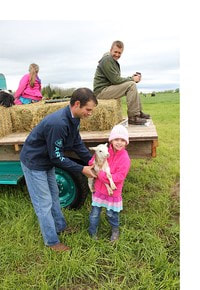
Brian and Hannah Harper are teaching their two young daughters how conservation positively impacts their dairy and managed grazing operation, while also benefiting the neighboring community, passing down lessons they learned from generations past. The Harpers partnered with USDA's Natural Resources Conservation Service (NRCS) to set up a rotational grazing operation, write a nutrient management plan, utilize cover crops and install a barnyard system. Learn how the Harpers diversified their farm to keep it thriving for future generations.
Read More (1,725 KB pdf)
Read More (1,725 KB pdf)
September - 2017
|
Dane County: Century Farm Restores Woodlands, Savanna and Trout Stream
Helmenstine Hillside Vue Farm, located in the Driftless area of western Dane County, has been in the family for over 100 years. Jerome and his wife, Jackie, worked with NRCS and FSA to restore a stream, improve wildlife habitat and restore woodlands. Read more about the USDA partnership that brought back habitat for woodpeckers, nighthawks, kestrels, bats and more. Read more (710 KB pdf) |
|
Walworth County: 16th Annual Prairie Walk Returns to Its Roots
Sixteen years ago, Ray and Sharon Rippel, of Burlington, Wis., hosted the very first Prairie Walk in Walworth County. In 2016, the Rippels again, hosted the Prairie Walk. Ray and Sharon partnered with NRCS and FSA to restore and actively manage their high quality prairie acres and add pollinator habitat. Read more (998 KB pdf) |
|
Wood County: Central Wisconsin Family Farms Diverse and Sustainable
Denise and John Hilgart own and operate 269 acres of farmland in Wood County, WI, just north of the city of Auburndale. The Hilgarts partnered with NRCS and FSA through various programs to install a rotational grazing system, complete grass and legume plantings, install a seasonal high tunnel, develop a nutrient management plan, and much more. Find out how the Hilgarts used the financial and technical assistance available through USDA to benefit their diverse operation. Read more (634 KB pdf) |
August - 2017

Craig and Nichol Swenson, of Columbia County, Wis., restored and actively manage their wetland easement and prairie property through the NRCS Wetland Reserve Program. The Swensons are also Directors of the Flyways Waterfowl Experience, which houses world class exhibits and interactive conservation displays, a duck blind theatre, waterfowl art and galleries, decoys, and much more. Learn more about how they partnered to restore their property, and plan a visit to the Flyways Waterfowl Experience to learn about their conservation efforts first-hand.
Eau Claire, Dodge and Pepin Counties
Madison, Wis. – August 31, 2017 – Welcome to the August edition of the Successes from the Field Series! You asked, we listened. Success stories directly from the field related to topics farmers and landowners care about: what works for cover crops in my area, what’s available to help pollinators, how can I help my soil and water quality, and more.
You’ll find answers in these stories, from farmers and landowners who successfully partner with us to receive technical and financial assistance in putting conservation to work on their farm. These farmers are making sound choices to keep their land productive and healthy, while also protecting our natural resources for the long term. These conservation choices benefit everyone. Look for more stories coming soon!
You’ll find answers in these stories, from farmers and landowners who successfully partner with us to receive technical and financial assistance in putting conservation to work on their farm. These farmers are making sound choices to keep their land productive and healthy, while also protecting our natural resources for the long term. These conservation choices benefit everyone. Look for more stories coming soon!
|
Eau Claire County
If you build it (habitat), they will come. The USDA's NRCS and FSA partnered to restore over 2,000 acres of habitat for the Karner blue butterfly in Eau Claire and Jackson counties through the FSA's Conservation Reserve Program, State Acres for Wildlife Enhancement. Over 2,000 acres were contracted to include the participation of 91 private landowners located within the high potential butterfly recovery area! Read more about the USDA partnership restoring habitat for this endangered species. Read more (1,536 KB pdf) |
|
Dodge County
A Leader in Conservation Dale Macheel, of Dodge County, operates Macheel Enterprises and Werld Farms. He is one of the foremost conservation-minded producers in the county, with over 1,000 cropland acres in production. He says taking care of the soil is his most important goal. With the help of NRCS, Dale participates in EQIP, CSP and FSA's Conservation Reserve Program. Read more about how he's transformed his soil, one conservation practice at a time. Read more (2,167 KB pdf) |
|
Pepin County
Partnering to Restore Fall Creek Mike Brion and his two sons run Brion Dairy LLC, a century farm with 500 dairy cows and 1,800 acres of alfalfa, corn, soybeans and rye. With the help of NRCS, Brion enrolled in the Fall Creek Water Quality Project to complete numerous water quality projects to improve surface and ground water quality, including a barnyard runoff control system, a waste storage facility and a wetland restoration. His two sons most recently worked with NRCS to restore Fall Creek, a trout stream that runs through the property. Read more about the steps taken in the steam restoration at Brion Dairy. Read more (812 KB pdf) |
Green Lake and Fond du Lac Counties...
Landowners in the Green Lake area have a lot to be proud of. That is what a multi-organizational group representing farmers, shoreline owners and the public plans to highlight at a free Conservation Field Day on Saturday, August 26 in Ripon, Wisconsin. Watch the video here.
August 22, 2017 – Success stories directly from the field related to topics farmers and landowners care about: what works for cover crops in my area, what’s available to help pollinators, how can I help my soil and water quality, and more.
You’ll find answers in these stories, from farmers and landowners who successfully partner with us to receive technical and financial assistance in putting conservation to work on their farm. These farmers are making sound choices to keep their land productive and healthy, while also protecting our natural resources for the long term. These conservation choices benefit everyone. Look for more stories coming soon!
You’ll find answers in these stories, from farmers and landowners who successfully partner with us to receive technical and financial assistance in putting conservation to work on their farm. These farmers are making sound choices to keep their land productive and healthy, while also protecting our natural resources for the long term. These conservation choices benefit everyone. Look for more stories coming soon!
|
The Red Cliff Band of the Lake Superior Chippewa Reservation worked with the U.S. Department of Agriculture's Natural Resources Conservation Service (NRCS) to restore and stabilize a streambank on Spirit Island in northern Wisconsin. Heavy rainfall events and lack of streambank vegetation caused unstable bank conditions and erosion. Read how NRCS provided technical assistance, working together with the tribe to stabilize the stream. |
Partnering with the Red Cliff Band of Lake Superior Chippewa Reservation |
________________________________________________________________

Columbia County
EQIP Helps Yorkshire Rose Farm Grazing Sheep Carole and Dave Pine run a sheep grazing operation on their 35-acre farm in south central Wisconsin. With the help of NRCS EQIP, they set up a successful rotational grazing operation that has been beneficial to the health of their animals and their land. Read more (934 KB pdf)
EQIP Helps Yorkshire Rose Farm Grazing Sheep Carole and Dave Pine run a sheep grazing operation on their 35-acre farm in south central Wisconsin. With the help of NRCS EQIP, they set up a successful rotational grazing operation that has been beneficial to the health of their animals and their land. Read more (934 KB pdf)
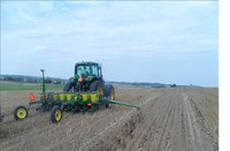
Barron County
Thinking Outside the Box
Alex and Mary Olson, of Breezy Hill Dairy in Dallas, Wis., operate a 550 cow facility. The Olsons use EQIP and CSP to implement the newest, innovative technologies on their farm. With the help of NRCS technical assistance, the Olsons also succeeded in reaching their 100% no-till goal. Read more (578 KB pdf)
Thinking Outside the Box
Alex and Mary Olson, of Breezy Hill Dairy in Dallas, Wis., operate a 550 cow facility. The Olsons use EQIP and CSP to implement the newest, innovative technologies on their farm. With the help of NRCS technical assistance, the Olsons also succeeded in reaching their 100% no-till goal. Read more (578 KB pdf)
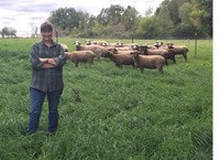
Washington County
Grazing for Soil Health
Val Jansen, of West Bend, Wis., wanted to improve the soil health of her 8.5 acres of cropland. Working with NRCS, she wrote a grazing plan and utilized EQIP to transition her cropland to a rotational grazing system. She also uses CSP and collects soil samples to measure her lands ever-increasing soil health. Read more (641 KB pdf)
Grazing for Soil Health
Val Jansen, of West Bend, Wis., wanted to improve the soil health of her 8.5 acres of cropland. Working with NRCS, she wrote a grazing plan and utilized EQIP to transition her cropland to a rotational grazing system. She also uses CSP and collects soil samples to measure her lands ever-increasing soil health. Read more (641 KB pdf)

These farmers are making sound choices to keep their land productive and healthy, while also protecting our natural resources for the long term. These conservation choices benefit everyone. Look for more stories coming soon!
Fond du Lac County
Produce With a Purpose Richard Slager and his wife, Dawn, of Fond du Lac County, are advocates for producing healthy fruits and vegetables and also teaching people nationally and internationally about sustainable agriculture. With the help of NRCS, the Slagers installed a seasonal high tunnel to jump start their growing season.
Read more (169 KB pdf)
Fond du Lac County
Produce With a Purpose Richard Slager and his wife, Dawn, of Fond du Lac County, are advocates for producing healthy fruits and vegetables and also teaching people nationally and internationally about sustainable agriculture. With the help of NRCS, the Slagers installed a seasonal high tunnel to jump start their growing season.
Read more (169 KB pdf)

Fond du Lac County
Frost Seeding Clover? It Works! Neil Drummy, a Wisconsin row crop farmer, owns and operates land in Dodge, Fond du Lac and Columbia Counties. Neil is consciously a good steward of the land in the conservation decisions he makes, while also looking for ways to increase yields without causing undo harm to the land he operates. With the help of NRCS, Neil frost seeded 24 acres of crimson clover into existing wheat.
Read more (248 KB pdf)
Frost Seeding Clover? It Works! Neil Drummy, a Wisconsin row crop farmer, owns and operates land in Dodge, Fond du Lac and Columbia Counties. Neil is consciously a good steward of the land in the conservation decisions he makes, while also looking for ways to increase yields without causing undo harm to the land he operates. With the help of NRCS, Neil frost seeded 24 acres of crimson clover into existing wheat.
Read more (248 KB pdf)
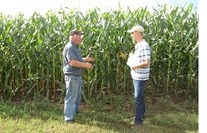
Oconto County
Double Duty Cover Crop Boosts Yields Jim Mahoney has been farming in Oconto County, near Suring, Wis., for 24 years. He has a typical rotation of corn, soybeans and winter wheat. In addition, he also crops acres of alfalfa and snap beans. The northeast Wis. landscape in Suring offers challenges, from steep sloping sands, to poorly drained lowlands. This is why Mahoney likes planting multi-species cover crops. Learn more about the cover crops he plants with the help of NRCS.
Read more (212 KB pdf)
Double Duty Cover Crop Boosts Yields Jim Mahoney has been farming in Oconto County, near Suring, Wis., for 24 years. He has a typical rotation of corn, soybeans and winter wheat. In addition, he also crops acres of alfalfa and snap beans. The northeast Wis. landscape in Suring offers challenges, from steep sloping sands, to poorly drained lowlands. This is why Mahoney likes planting multi-species cover crops. Learn more about the cover crops he plants with the help of NRCS.
Read more (212 KB pdf)

Polk County
Pit be Gone Greg and Karen Peper, of Polk County, Wis., are former dairy operators who decided to transition their farm to crops and a small beef herd. They own around 250 acres near Centuria, Wis. The farm is located between three large lakes, Balsam, Loveless, and Long Lake, so, water quality has always been a concern for the Peper family. With the help of NRCS, an unused manure storage structure was removed to alleviate any potential animal, water or human safety issues.
Read more (279 KB pdf)
Pit be Gone Greg and Karen Peper, of Polk County, Wis., are former dairy operators who decided to transition their farm to crops and a small beef herd. They own around 250 acres near Centuria, Wis. The farm is located between three large lakes, Balsam, Loveless, and Long Lake, so, water quality has always been a concern for the Peper family. With the help of NRCS, an unused manure storage structure was removed to alleviate any potential animal, water or human safety issues.
Read more (279 KB pdf)
Restoration Leads to Flourishing Wetlands
Jefferson County Landowner Brings Wildlife Home
Ohne and Karen Raasch, of Lake Mills, Wisconsin, wanted their wet, flooded areas of land to go back as nature intended, to a flourishing, restored wetland.
The Raaschs partnered with the U.S. Department of Agriculture, Natural Resources Conservation Service (NRCS) to develop a restoration plan on their property and acquire a permanent easement through the Wetland Reserve Program. NRCS provided technical and financial assistance, enabling seeding of highly eroded fields, digging and scraping of shallow ponds, planting of food plots for wildlife and more. Click below to read the full story.
The Raaschs partnered with the U.S. Department of Agriculture, Natural Resources Conservation Service (NRCS) to develop a restoration plan on their property and acquire a permanent easement through the Wetland Reserve Program. NRCS provided technical and financial assistance, enabling seeding of highly eroded fields, digging and scraping of shallow ponds, planting of food plots for wildlife and more. Click below to read the full story.
Click on the following link for this great story:
Veteran Farmer Grazes His Way to Success
https://content.govdelivery.com/accounts/USDANRCS/bulletins/18eba8b
Veteran Farmer Grazes His Way to Success
https://content.govdelivery.com/accounts/USDANRCS/bulletins/18eba8b
Discovery Farms Introduces
The WaterWay Network
What is it?
A password protected, online discussion forum focused on using science
and local experience to answer all of the latest conservation questions.
Who can join?
Currently, registration is open to Wisconsin and Minnesota farmers and crop consultants. Handpicked experts will be added every month. We’re keeping it private
to foster open dialogue. If you’re interested but aren’t sure if you qualify,
reach out to see if there are ways you can be involved.
What can it offer producer-led watershed groups?
An opportunity to communicate internally with your group, brainstorm with
other producer-led groups, and participate in conservation related discussions.
Read more about the benefits.
Upcoming Expert:
In March, Rachel Rushmann will be on the site answering
questions and talking about the producer-led grant program.
Visit www.waterwaynetwork.org to register or forward this email.
Questions? Contact Erica Olson at 715.983.5668 or [email protected].
The WaterWay Network
What is it?
A password protected, online discussion forum focused on using science
and local experience to answer all of the latest conservation questions.
Who can join?
Currently, registration is open to Wisconsin and Minnesota farmers and crop consultants. Handpicked experts will be added every month. We’re keeping it private
to foster open dialogue. If you’re interested but aren’t sure if you qualify,
reach out to see if there are ways you can be involved.
What can it offer producer-led watershed groups?
An opportunity to communicate internally with your group, brainstorm with
other producer-led groups, and participate in conservation related discussions.
Read more about the benefits.
Upcoming Expert:
In March, Rachel Rushmann will be on the site answering
questions and talking about the producer-led grant program.
Visit www.waterwaynetwork.org to register or forward this email.
Questions? Contact Erica Olson at 715.983.5668 or [email protected].
For More Information on any of the topics below, click on the corresponding website.
FARMERS’ GUIDE TO THE CONSERVATION STEWARDSHIP PROGRAM
http://sustainableagriculture.net/wp-content/uploads/2016/11/CSP-digital-v3-Nov-2016-FINAL.pdf
ORGANIC FARMERS’ GUIDE TO THE CONSERVATION RESERVE PROGRAM—FIELD BORDER BUFFER INITIATIVE
http://sustainableagriculture.net/wp-content/uploads/2016/05/2016_5-CRP-organic-field-border-buffer-guide-FINAL.pdf
GRASSROOTS GUIDE TO FEDERAL FARM AND FOOD PROGRAMS
http://sustainableagriculture.net/publications/grassrootsguide/
http://sustainableagriculture.net/wp-content/uploads/2016/11/CSP-digital-v3-Nov-2016-FINAL.pdf
ORGANIC FARMERS’ GUIDE TO THE CONSERVATION RESERVE PROGRAM—FIELD BORDER BUFFER INITIATIVE
http://sustainableagriculture.net/wp-content/uploads/2016/05/2016_5-CRP-organic-field-border-buffer-guide-FINAL.pdf
GRASSROOTS GUIDE TO FEDERAL FARM AND FOOD PROGRAMS
http://sustainableagriculture.net/publications/grassrootsguide/
| microloans_for_farmers.pdf | |
| File Size: | 608 kb |
| File Type: | |







